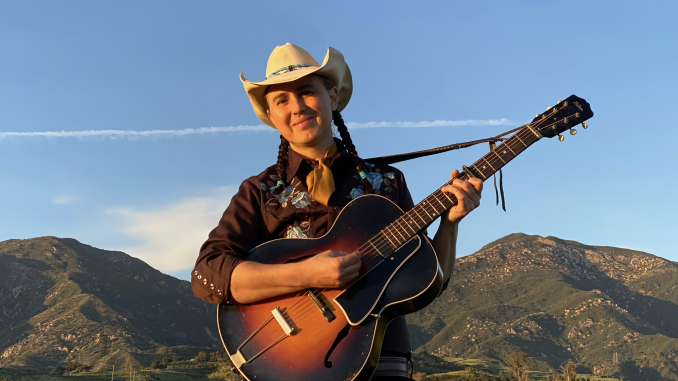
California-based country/Americana singer-songwriter Julian Talamantez Brolaski recently released their new album, ‘It’s Okay Honey’, combining the language of classic country with lyrical innovation and pacing, and we’re delighted to premier their new video today ‘No More Lonesome Heartache‘, one of the album’s highlights with a great melody and visceral lyrics such as: “there’s a hook in my eye a knife in my gullet”. Ouch.
Brolaski, a mixed-race, transgender poet, makes traditional, inventive Americana music, adding poetic lyricism to melodies inspired by some of country and western music’s original recording stars and most beloved sounds. Classical piano lessons, the poetry and queer country music scenes on both coasts, and years spent studying languages gave Brolaski the foundation to create what Country Queer called “sweet, cutting, and melancholy” music with various bands and now as a solo artist.
We chatted to Julian about their song, the video and plans for the rest of 2023:
What is this song about? What inspired you to write it?
The song is sort of a spell to eradicate heartache. Some parts of the song are nonsense, like “are you a prophet are you a leaflet“—and parts were inspired by real life—falling in love and lust with someone during lockdown. I stole a line from the anonymous medieval poem “Westron Wynde“ (Western Wind) but varied it a bit. “Westron Wynde“ goes: “Western wind, when wilt thou blow / The small rain down can rain.“ My line goes: “Are you a prophet, are you a leaflet / Can the small rain down can rain.“ It’s such a strange line—“the small rain down can rain“—and adding another “can“ makes it even more strange. But I’m attracted to that strangeness and beauty, and poetry is all about thievery anyway.
What do you hope this song says to people who hear it?
I hope it says: get up and dance! The song has a great train beat and groove, and the solos are on fire. I hope bits of the lyrics come through to them, and it reminds them of something in their own life, so that they can find an emotional entry into the song.
Let’s talk about the video. Who did you work with on the video, and whose ideas were the video treatment and visuals? Where did you film it?
I worked on the video with my friend, Owen Duncan. He does video and content for the Santa Barbara Museum of Natural History, and he’s a brilliant nature videographer. My friend, Jen, from the band Lone Quail, also helped out, and my uncle Pete, and my friend, Shaka Clark, was the dancer. Owen had all the ideas for the sequencing and the general arc of the video, and for the part where I’m writing lyrics on the sand. All I knew was that I wanted to film in the foothills at sunset and at the beach. We shot some of the sequences in the San Marcos foothills, at the base of the Santa Ynez mountains in Santa Barbara. And the beach scenes are at Haskell’s Beach in Goleta, close to where I live. It was also Owen’s idea to get some dancing in there, so I’m happy to say the video has two trans cowboys two-stepping on the beach.
How did the video come together? Any stories about its creation that you can share? Any funny stories from the shoot?
In the rough cut, Owen had inserted all of this B-roll of tidepools in Santa Barbara. It very much resonated with our friendship, which seems to consist mostly of nature walks on the beach. But it didn’t really make sense with the song, and so I asked him why all the tidepool shots. He said, “Oh, because of the lyric, ‘with those cornflower eyes, you look like the tidepool / Cupid’s sharpest dart would find.‘” I started laughing, because the line is “with those cornflower eyes, you look like the type who / Cupid’s sharpest dart would find.“ I love that mistake. Like, “Excuse me while I kiss this guy.“
What are your plans for the rest of this year?
Touring this album as much as possible. I also have a chapbook of poems coming out in the fall, “Sky Hammer,“ from Asterion Projects, and I’ll be doing some readings for that. I’m giving some talks on poetry as part of the Bagley Wright Lecture Series. And finishing up a book of poems called “Give Everything to Poetry.“


